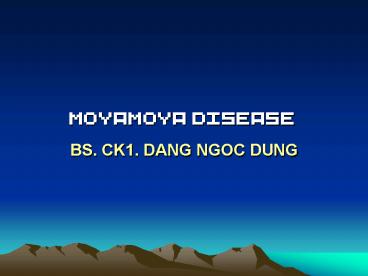MOYAMOYA DISEASE - PowerPoint PPT Presentation
1 / 16
Title:
MOYAMOYA DISEASE
Description:
Moyamoya disease is a unique chronic progressive cerebrovascular disease ... ETIOLOGY. Unknown. Familial occurrence of approximately 10% of cases ... – PowerPoint PPT presentation
Number of Views:541
Avg rating:5.0/5.0
Title: MOYAMOYA DISEASE
1
MOYAMOYA DISEASE
- BS. CK1. DANG NGOC DUNG
2
INTRODUCTION
- Moyamoya disease is a unique chronic progressive
cerebrovascular disease characterized by
bilateral stenosis or occlusion of the arteries
around the circle of willis with prominent
arterial collateral circulation - The annual incidence of MM is 0.35 to 0.94 per
100.000 population. the prevalence of MM is 3.2
to 10.5 per 100.000 population (Japan) - Asian 0.28 per 100.000 population
- Age distribution in child 10 14 y.old
- Male/Female 1/1.8 to 1/2.2
3
INTRODUCTION
- Moyamoya disease was first described in Japan in
1957 (Suzuki) - Many similar cases have subsequently been
reported, mainly in Japan and other Asian
countries. the disease is found less frequently
in North America and Europe
4
ETIOLOGY
- Unknown
- Familial occurrence of approximately 10 of cases
- Familial Mm.D has been linked to chromosomes
3P24.2-P26, 6Q25, 8Q23, 12P12, and 17Q25
5
CLINICAL FEATURES
- Transient ischemic attack (TIA)
- Ischemic stroke
- Hemorrhagic stroke
- Epilepsy
- In children, symptomatic episodes of ischemia may
be triggered by exercise, crying, coughing,
straining, fever or hyperventilation
6
NEUROIMAGING
- CT scan infarction may involve cortical and
subcortical regions. In the patients with
parenchymal hemorrhage, cranial CT usually show a
high density area indicating blood in the basal
ganglia, thalamus and/or ventricular system - CTA can also demonstrate the abnormal vessels of
MM.D, including the collateral MM vessels in the
basal ganglia - MRI acute ischemic brain lesions, in some cases,
dilated collateral vessels - MRA, DSA
7
DIAGNOSIS
- The diagnosis of MM.D is based upon the
characteristic angiographic appearance of
bilateral stenoses affecting the distal internal
carotid arteries proximal circle of willis
vessels, along with the presence of prominent
basal collateral vessels
8
ACUTE MANAGEMENT
- Acute management is mainly symtomatic and
directed towards reducing elevated intracranial
pressure, improving cerebral blood flow, and
controlling seizures. In patients with
intracerebral hemorrhage, ventricular drainage,
and/or hematoma, removal is often required.
9
SECONDARY PREVENTION
- There is no curative treatment for MM.D
- Secondary prevention for patients with
symptomatic MM syndrome is largely centered on
surgical revascularization techniques
10
(No Transcript)
11
(No Transcript)
12
(No Transcript)
13
(No Transcript)
14
(No Transcript)
15
(No Transcript)
16
THANK YOU

